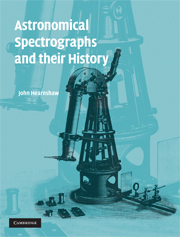Book contents
- Frontmatter
- Contents
- Preface
- Acknowledgements
- 1 The historical development of astronomical spectroscopes and spectrographs
- 2 The theory of spectroscopes and spectrographs
- 3 High resolution spectrographs
- 4 Solar spectrographs and the history of solar spectroscopy
- 5 Objective prism spectrographs
- 6 Ultraviolet and nebular spectroscopy
- 7 Multi-object spectrographs
- 8 Ten pioneering spectrographs of the late twentieth century
- Figure sources and acknowledgements
- Name index
- Subject index
8 - Ten pioneering spectrographs of the late twentieth century
Published online by Cambridge University Press: 07 September 2010
- Frontmatter
- Contents
- Preface
- Acknowledgements
- 1 The historical development of astronomical spectroscopes and spectrographs
- 2 The theory of spectroscopes and spectrographs
- 3 High resolution spectrographs
- 4 Solar spectrographs and the history of solar spectroscopy
- 5 Objective prism spectrographs
- 6 Ultraviolet and nebular spectroscopy
- 7 Multi-object spectrographs
- 8 Ten pioneering spectrographs of the late twentieth century
- Figure sources and acknowledgements
- Name index
- Subject index
Summary
INTRODUCTION TO SPECTROGRAPHS OF THE LATE TWENTIETH CENTURY
In this chapter, ten outstanding spectrographs which had their first light in the late twentieth or early twenty-first centuries are presented. The section covers five high resolution instruments, four at low resolution and one spectrograph with multiple capabilities that includes low, medium and high resolution modes. All were commissioned between 1984 and 2003 and they are presented in chronological order of their entry into service.
The choice of ten representative spectrographs from the several dozen commissioned over this two decade period was a matter of some difficulty. The final choice was my own personal one. I wanted to show that spectrograph design has become a pursuit of great innovation, ingenuity and also complexity, at times verging towards a creative art-form involving cutting edge optical technology. In this period, huge developments were made in the use of optical fibres, larger and improved efficiency CCD detectors, the production of large mosaic gratings, the development of grisms and volume phase holographic gratings, the design and manufacture of multi-element dioptric cameras with specialized antireflection coatings, high reflection coatings on mirrors, and the extension of the wavelength range both down into the near ultraviolet at the atmospheric limit and also to the far red near one micrometre.
- Type
- Chapter
- Information
- Astronomical Spectrographs and their History , pp. 195 - 213Publisher: Cambridge University PressPrint publication year: 2009



